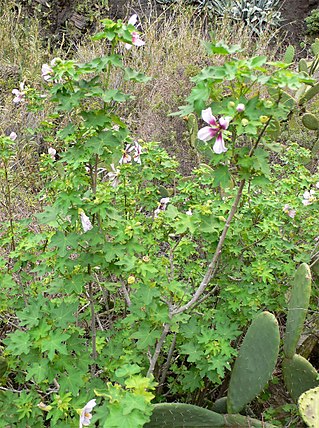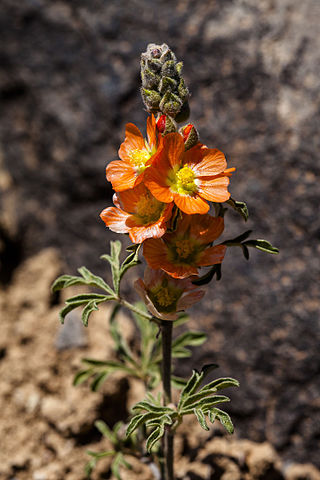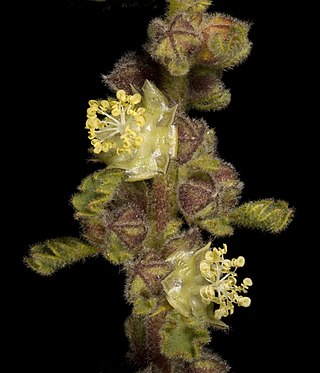
Abutilon is a large genus of flowering plants in the mallow family, Malvaceae. It is distributed throughout the tropics and subtropics of the Americas, Africa, Asia, and Australia. General common names include Indian mallow and velvetleaf; ornamental varieties may be known as room maple, parlor maple, or flowering maple. The genus name is an 18th-century Neo-Latin word that came from the Arabic ’abū-ṭīlūn, the name given by Avicenna to this or a similar genus.

Sphaeralcea is a genus of flowering plants in the mallow family (Malvaceae). There are about 40-60 species, including annuals, perennials, and shrubs. Most originate in the drier regions of North America, with some known from South America. They are commonly known as globemallows, globe mallows, false mallows or falsemallows. The name of the genus is derived from the Greek words σφαῖρα (sphaira), meaning "sphere," and αλκεα (alkea), meaning "mallow."
The Anaconda Copper Mining Company, known as the Amalgamated Copper Company from 1899 to 1915, was an American mining company headquartered in Butte, Montana. It was one of the largest trusts of the early 20th century and one of the largest mining companies in the world for much of the 20th century.

Sidalcea is a genus of the botanical family Malvaceae. It contains several species of flowering plants known generally as checkerblooms or checkermallows, or prairie mallows in the United Kingdom. They can be annuals or perennials, some rhizomatous. They are native to West and Central North America.

Sphaeralcea incana, with the common names gray globemallow and soft globemallow, is a desert plant in the mallow family (Malvaceae).

Trochetiopsis ebenus, the dwarf ebony or Saint Helena ebony, is a species of flowering plant that is endemic to the island of Saint Helena in the southern Atlantic Ocean. It is not related to the ebony of commerce, but is instead a member of the mallow family, Malvaceae. Saint Helena ebony is now critically endangered in the wild, being reduced to two wild individuals on a cliff, but old roots are sometimes found washed out of eroding slopes. These are collected on the island and used for inlay work, an important craft on Saint Helena. A related species, Trochetiopsis melanoxylon, is now completely extinct.

Malva acerifolia, also frequently known under the synonyms Lavatera acerifolia or Malva canariensis is a shrub endemic to the Canary Islands, belonging to the family Malvaceae.

Iliamna is a small genus of flowering plants in the mallow family, endemic to North America. It is related to the bush mallows of California (Malacothamnus) and to Phymosia of Mexico, Central America and the Caribbean. These perennial herbs are known commonly as wild hollyhocks and sometimes as globe mallows, Kankakee mallow, Kankakee globe mallow, and Streambank wild hollyhock. More often, the latter terms refer to members of the genus Sphaeralcea, which belong, like Iliamna, to the "typical" mallow tribe (Malveae) of the mallow and hibiscus subfamily Malvoideae. The name of the genus, proposed by Edward Lee Greene, appears to be a reference to Iliamna Lake in Alaska, even though the genus Iliamna does not occur in Alaska

Sphaeralcea coccinea, commonly known as the scarlet globemallow, scarlet mallow, cowboy's delight, prairie mallow, red false mallow, or simply as globe mallow is a perennial plant growing 10–30 cm tall from spreading rhizomes with a low habit. They have grayish stems with dense, star-shaped hairs and alternately arranged leaves. The leaf blades are 2–5 cm long, palmately shaped, and deeply cut, with 3–5 main wedge-shaped segments. The undersides of the leaves have gray hairs. The 1–2.5 cm wide flowers are reddish-orange and saucer-shaped, with 5 notched, broad petals, in small terminal clusters. It produces numerous stamen which surround the pistils as a tube. Plants flower from May to October in southern regions and May to July in northern regions. The plant produces a dry "fruit" called a schizocarp, which after maturity, breaks into roughly 10 or more seed segments.

Sphaeralcea ambigua, is a species of flowering plant commonly known as desert globemallow or apricot mallow, for its predominantly orange blooms. It has fuzzy grey-green leaves. It is a member of the genus Sphaeralcea in the mallow family (Malvaceae).

Iliamna corei is a rare species of flowering plant in the mallow family known by the common name Peters Mountain mallow. It is endemic to Virginia in the United States, where it is known only from Peters Mountain in Giles County. A single occurrence remains. This is a federally listed endangered species. It is considered "one of the rarest native plants in the United States."

Pediocactus sileri is a rare species of cactus known by the common names Siler's pincushion cactus and gypsum cactus. It is native to southwestern Utah and northwestern Arizona in the United States. It is limited to a specific type of soil, individuals are often spaced far apart, and the species is threatened by a number of human activities such as off-road vehicle use, poaching, and uranium mining. This is a federally listed threatened species of the United States.

Pediocactus bradyi subsp. despainii is a rare species of cactus known by the common names Despain's cactus and San Rafael cactus.

Hesperidanthus argillaceus, syn. Schoenocrambe argillacea, is a species of flowering plant in the mustard family, known by the common names clay reed-mustard, Uinta Basin plainsmustard, and clay thelypody.

Hesperidanthus barnebyi, syn. Schoenocrambe barnebyi, is a species of flowering plant in the mustard family, known by the common names Barneby reed-mustard, Syes Butte plainsmustard, and Barneby thelypody. It is endemic to Utah in the United States, where it is known only from Emery and Wayne Counties. It is threatened by habitat degradation and destruction. It is federally listed as an endangered species of the United States.

Plants for the production of lead are generally referred to as lead smelters. Primary lead production begins with sintering. Concentrated lead ore is fed into a sintering machine with iron, silica, limestone fluxes, coke, soda ash, pyrite, zinc, caustics or pollution control particulates. Smelting uses suitable reducing substances that will combine with those oxidizing elements to free the metal. Reduction is the final, high-temperature step in smelting. It is here that the oxide becomes the elemental metal. A reducing environment pulls the final oxygen atoms from the raw metal.

Blue Diamond Hill is a 4,931-foot (1,503 m) peak that borders Red Rock Canyon in Nevada, west of Las Vegas. The Blue Diamond Mine is located on the hill, and the small community of Blue Diamond, Nevada is located nearby. Several housing projects have been proposed for the hill since 2002.

Lawrencia densiflora is a species of plant in the mallow family, Malvaceae. It is endemic to Western Australia

Sphaeralcea parvifolia, commonly called small-leaved globe-mallow or small-leaf globemallow, is a species of plant native to the western United States in the Great Basin and Colorado River drainage. It is medium sized herbaceous species that has showy orange flower spikes. It is used in wildflower and dry gardens.



















